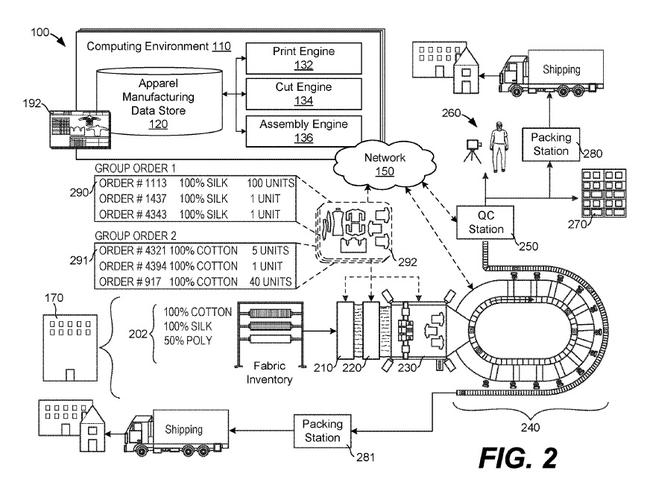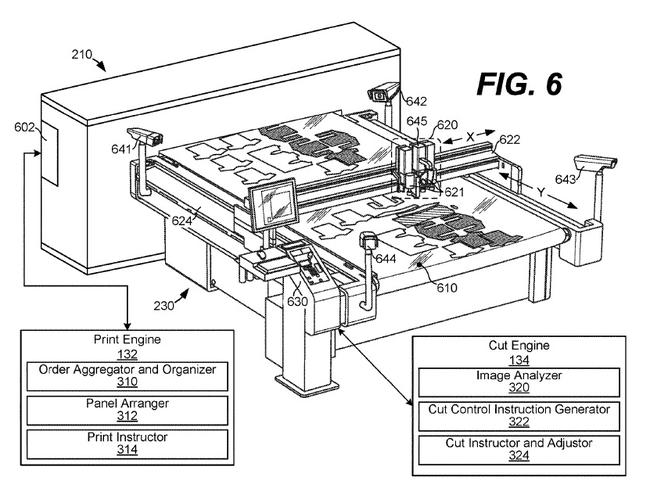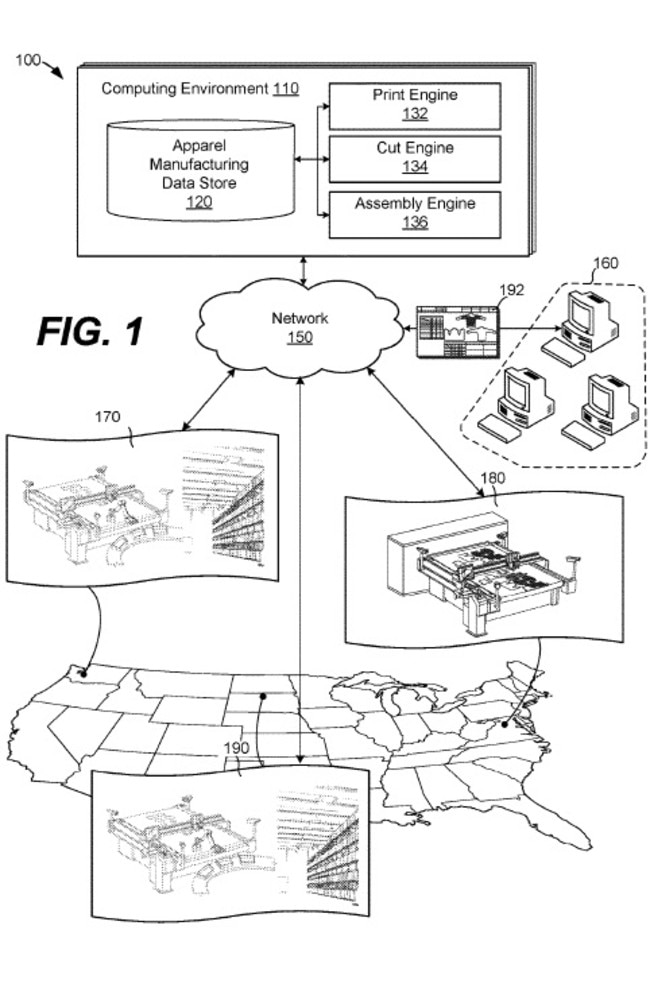Amazon unveils plans for on-demand clothing factory
AS AMAZON breaks its silence on its Australian launch, it has quietly unveiled plans for another game-changing invention.
NOT content with destroying traditional bricks-and-mortar retailers like Wal-Mart, Amazon has set its sights on the rag trade.
A patent application for an “on-demand apparel manufacturing” system, approved by the US Patent Office this week, has revealed the e-commerce giant plans to become a major player in the clothing industry.
The patent, which Amazon first applied for in 2015, describes a hi-tech system which would quickly produce clothing — and potentially other products such as footwear and accessories — only after an order is placed.
The system includes a textile printer, textile cutter and a computing device.
“Using the panels cut out from the textile sheets, the computing environment generates instructions for the assembly of the textile products defined in the orders and coordinates an efficient assembly process for the products,” the patent reads.
“According to aspects of the embodiments, the computing environment generates and provides assembly instructions to a textile assembly production line. Based on the assembly instructions, the textile assembly production line directs the panels to various sewing stations, for example, for assembly.
“Once various textile products are printed, cut, and assembled according to the orders, they can be processed through a quality check, photographed for placement in an electronic commerce system, shipped to customers, and/or stored in a materials handling facility for order fulfilment.”
In the 29-page document, the inventors write that the “apparel manufacturing industry relies upon various resources, processes, and equipment to produce finished garments, accessories, footwear, etc.”, with the process to manufacture a garment generally including “garment design, fabric production and/or printing, and panel cutting and sewing”.
“Many aspects of apparel manufacturing processes are relatively time-consuming and require the co-ordination of many different geographically dislocated suppliers, vendors, manufacturers, and retailers,” they write.
“By aggregating orders from various geographic locations and co-ordinating apparel assembly processes on a large scale, the embodiments provide new ways to increase efficiency in apparel manufacturing.”
The patent notes that the system it describes can be “applied to the manufacture of a wide array of products, including clothing or fabric products, accessories (e.g., scarfs, gloves, hats, bags, belts, etc.), footwear, bedding, curtains, towels, etc., in a wide variety of materials, including but not limited to paper, plastic, leather, rubber, and other materials”.




Tech website Recode, which first reported the patent, points out that Amazon already has a massive apparel section bigger than its electronics catalogue, with at least eight of its own clothing brands ranging from kids clothes to women’s dresses and men’s shirts. It also has its own bedding and towel brand called Pinzon.
It comes as the e-commerce giant breaks its silence, officially confirming it has begun searching for a location for its first Australian logistics facility — likely to be in Melbourne or Sydney — following months of speculation.
“Amazon Web Services launched an Australian region in 2012, we launched a Kindle store on Amazon.com.au in 2013, and we now have almost 1000 employees in the country. The next step is to bring a retail offering to Australia, and we are making those plans now,” an Amazon spokesman said in a statement.
“We are excited to bring thousands of new jobs to Australia, millions of dollars in additional investment, and to empower small Australian businesses through Amazon Marketplace.
“We are optimistic that by focusing on the things we believe customers value most — low prices, vast selection, and fast delivery — over time we’ll earn the business of Australian customers.”
On Thursday, Amazon invited local businesses to sign up to sell their products on its Marketplace platform in Australia. “Since 2000, Amazon has been helping businesses increase sales and reach new customers,” a statement on Amazon.com.au said.
“Sales through Amazon Marketplaces now represent 50 per cent of all items sold on Amazon websites globally. There are already thousands of Australian businesses selling their products on existing Amazon Marketplaces.
“We are excited to bring the Amazon Marketplace to Australia next. Whether your business is new or you are looking to grow your sales, Amazon can provide you with an e-commerce solution to meet your needs. Become a seller on the Amazon Australia Marketplace and put Amazon’s e-commerce expertise to work for your business.”
A report by Macquarie last month estimated that by 2025 Amazon could take one quarter of online retail sales — which would at that point account for 12.5 per cent of total retail sales — equating to revenue of $14.5 billion.
But the outlook for Australian retailers is not “imminent disaster”. “On the micro level, incumbents will need to address inadequacies in pricing, customer engagement/loyalty, data analytics, website speed and ease-of-use and fulfilment,” Macquarie analysts Andrew McLennan and Elijah Mayr wrote.
“On a macro level, online is forecast to capture around 30 per cent of total retail sales growth which leaves a lower amount of growth available to the existing fleet of physical stores. The near-universal experience from overseas is that the leading category players can prevail, but inevitably with a smaller, more effective property footprint.
“However, we believe the impact of Amazon will take a number of years to make material impact and, assuming no mitigation, the earnings implications for listed retailers looks, in some cases, to be more than factored into share prices at current levels.”
The investment bank rated Wesfarmers, Metcash, JB Hi-Fi and Myer stocks as outperform. “Based on our analysis, there is risk to discount department stores which impacts Wesfarmers only modestly at group level and Metcash may actually benefit should Amazon require a strategic partner in grocery supply,” the report said.
“On our estimates, JB Hi-Fi is more than adequately pricing in the downside risk of an Amazon entry, while Myer is addressing (albeit, slowly) its excessive store footprint, repositioning its cost base and improving its relevance to customers.”
Market research firm Roy Morgan said Amazon was timing its expansion in Australia well as more tech-savvy shoppers buy online. More than 8.7 million Aussie consumers bought one or more products via the internet in any given four-week period last year.
“With online sales in almost all retail categories tracking steadily upwards, the conditions couldn’t be riper for Amazon’s imminent Australian launch,” Roy Morgan said.
The online retail behemoth has annual global sales of more than $133 billion ($US100 billion) and last reported in February a 22 per cent rise in revenue to $58.2 billion ($US43.7 billion) for the fourth quarter.
Amazon said it had 100,000 sellers making sales of more than $133,000 ($US100,000) on its US platform in 2016. It has 11 online marketplaces worldwide, including in the UK, across Europe, China and Japan.
— with AAP




